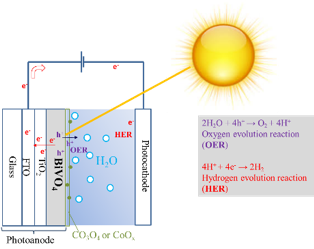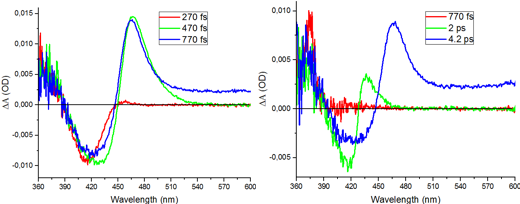Speaker
Description
BiVO4 is one of the most promising materials to be used as photoanodes in photoelectrochemical cells (PEC) for water splitting (Figure 1). To improve the light absorbance and charge carrier utilization performance of BiVO4, it is of key importance to understand charge transportation to the interface and interfacial transfer mechanism upon light absorption.

Figure-1: Photoelectrochemical cell and water splitting reactions.
The recombination dynamics of BiVO4 is one of the main obstacle for the water oxidation. Although there are proposed models for the recombination dynamics of bare and doped BiVO4 [1-2], there is a lack of data concerning environmental and operational conditions. Utilizing the Ultrafast transient absorption spectroscopy (UTAS) in operando conditions to understand the charge transfer dynamics shows encouraging results.
In order to have a sufficient water oxidation efficiency, the surface engineering of BiVO4, such as co-catalyst and/or doping, is inevitable. However, the deficiency of a theory or a robust model for the dynamics of intermediate states in operational conditions limits scientists to benefit from the surface modifications. In UTAS, negative absorption difference corresponds to ground state bleach, while the positive features are believed to be hole absorption for some metal-oxide semiconductors. Dynamics of intermediate states can be determined by UTAS. The hole-scavengers are commonly utilized in kinetic measurements and their effect on the dynamics can be noticed in Figure 2. UTAS behavior of BiVO4 forms at later times for the sample in scavenger which indicates the mid-gap states existence.

Figure-2: Time-evolution spectra of bare BiVO4 in air (left) and in hole scavenger (Na2SO3)(right).
In this study, we investigate the charge carrier dynamics of CoOx/BiVO4 and N-doped BiVO4 photoanode by utilizing UTAS. The former is believed to affect both catalytic activity of oxidation and suppression of recombination, which is a hot debate [3]. The latter improved the photon absorption and charge transport of BiVO4 [4]. This study aims to gain information of CoOx and nitrogen states on BiVO4 surface in both air and electrolyte via UTAS. Furthermore, we work on these samples in running cell conditions to determine the accurate role of such surface modifications on photo-electrochemical performance for BiVO4 based photoanode. Improved lifetimes of CoOx/BiVO4 and N-doped BiVO4 in different reaction environments will be presented, along with a proposed model for transition dynamics.
References:
1) Ravensbergen et al, J. Phys. Chem. C 2014, 118, 27793−27800
2) Pattengale et al, J. Phys. Chem. C 2016, 120, 1421−1427
3) Zachaus et al, Chem. Sci., 2017, 8, 3712–3719
4) Kim, T. W. et al, Nat. Commun. 6, 8769 (2015)


